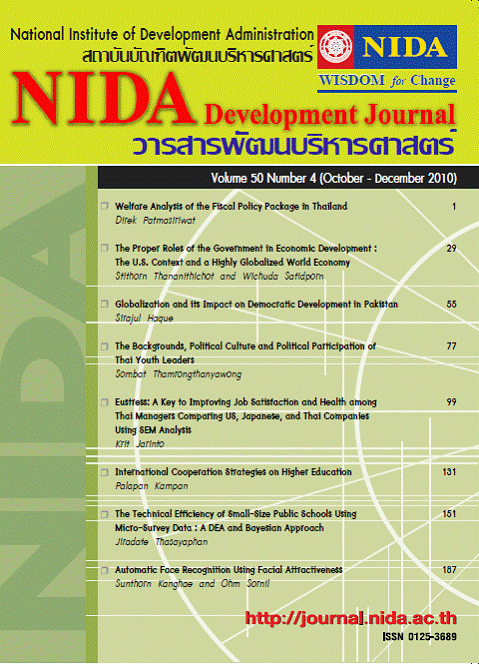The Technical Efficiency of Small-Size Public Schools Using Micro-Survey Data: A DEA and Bayesian Approach การวิเคราะห์ข้อมูลจุลภาคเพื่อทำนายประสิทธิภาพทางเทคนิค ของโรงเรียนรัฐขนาดเล็ก โดยวิธี DEA และ Bayesian
Keywords:
Technical Efficiency, Educational output, Accountability RelationshipAbstract
This paper examines technical efficiency among small-size schools in two provinces of Thailand by employing Data Envelopment Analysis. The survey techniques, Public Expenditure Tracing Survey and Quantitative Service Delivery Survey, are used as research instruments. The average efficiencies in constant returns to scale production technology are 83.4% and the variable returns to scale are 93.6%, respectively. Subsequently, we examine a factor that affects the degree of efficiency using the heteroscedastic Gibbs sampling Tobit model, where the data are censored between 0% and 100%. The results suggest that the schools in each province exhibit significant differences in efficiency. The teacher absence rate and vacancy rate are negatively correlated with school efficiency scores. However, parent education, school size, ratio of female to male students, and parent participation are significantly in explaining school efficiency. The school-based management framework, which is an accountability relationship among policymakers, service providers, and clients, is introduced to explain school performance.
บทความนี้วัตถุประสงค์เพื่อทำนายประสิทธิภาพทางเทคนิคของโรงเรียนของรัฐขนาดเล็กใน 2 จังหวัดทางภาคตะวันออกเฉียงเหนือโดยใช้เทคนิค Data Envelopment Analysis การสำรวจกลุ่มตัวอย่างใช้เครื่องมือวิจัยที่เรียกว่า Public Expenditure Tracking Surveys และ Quantitative Service Delivery Surveys ซึ่งผลการทำนายประสิทธิภาพโดยใช้สมมุติฐาน constant returns to scale มีค่าเท่ากับ 83.4% และสำหรับสมมุติฐาน variable returns to scale มีค่าเท่ากับ 93.6% การทดสอบในขั้นที่สองใช้ตัวแบบ heteroscedastic Gibbs sampling Tobit ซึ่งคะแนนประสิทธิภาพมีค่าระหว่าง 0% ถึง 100% ในการวิเคราะห์แสดงให้เห็นว่า โรงเรียนจากทั้ง 2 จังหวัดมีคะแนนประสิทธิภาพแตกต่างกันอย่างมีนัยสำคัญ อัตราการขาดงานและอัตราการว่างงานทำให้ประสิทธิภาพโรงเรียนลดลง อย่างไรก็ตาม ระดับการศึกษาของผู้ปกครอง ขนาดของโรงเรียน อัตราส่วนนักเรียนหญิง และการมีส่วนร่วมของผู้ปกครองทำให้ประสิทธิภาพของโรงเรียนสูงขึ้นอย่างมีนัยสำคัญ การอธิบายประสิทธิภาพของโรงเรียนใช้กรอบความคิดการจัดการโดยโรงเรียน ซึ่งเป็นความสัมพันธ์ของความรับผิดชอบระหว่าง ผู้กำหนดนโยบาย ผู้ให้บริการ และผู้รับบริการ





